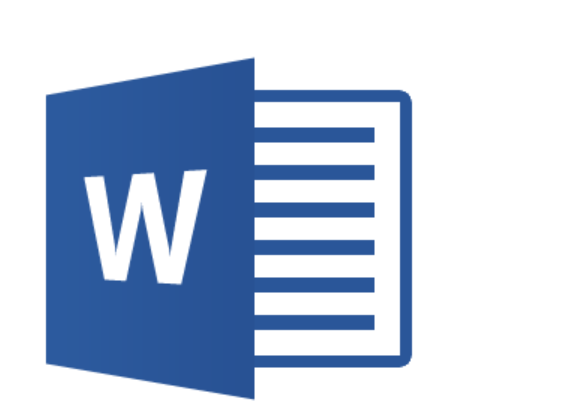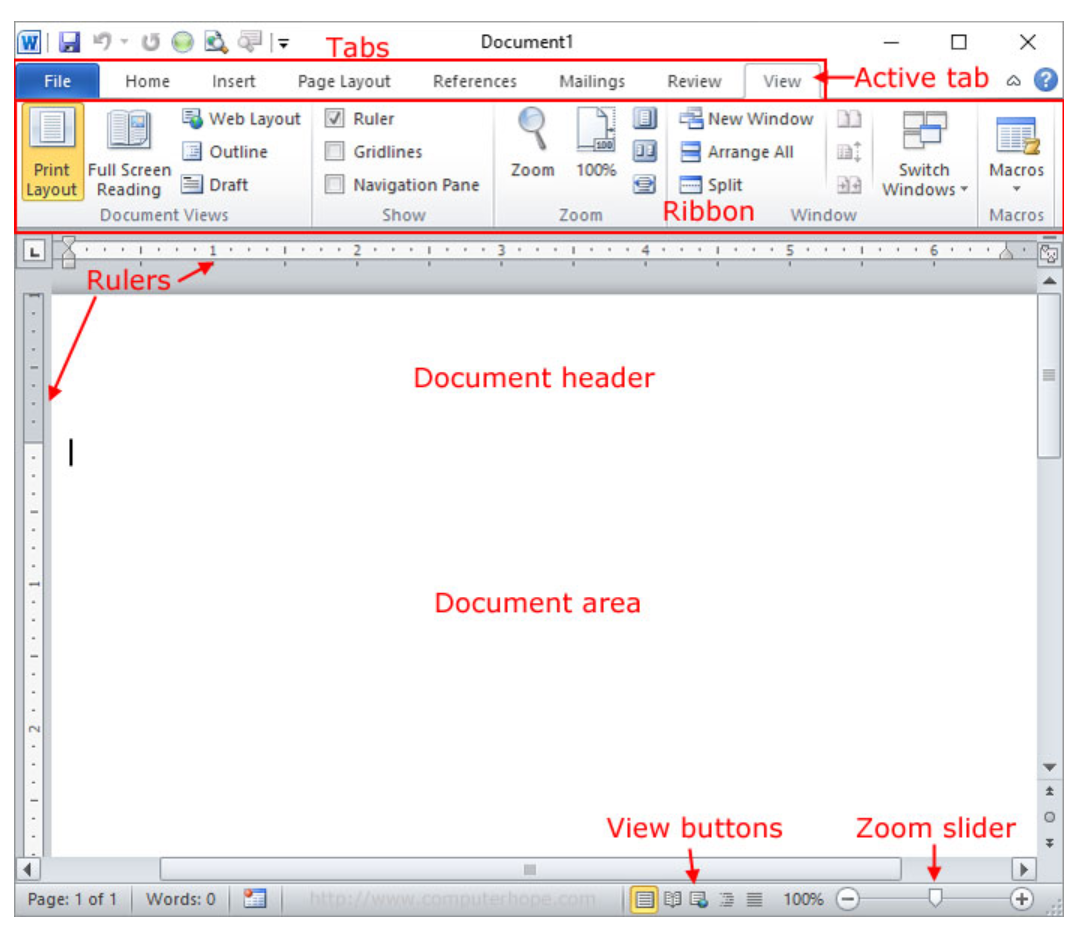Word processor
Sometimes abbreviated as WP, a word processor is a software program capable of creating, storing, and printing typed documents.
Today, the word processor is one of the most frequently used software programs on a computer, with Microsoft Word being the most popular word processor.

Word processors can be used to create multiple types of files, including text files (.txt), rich text files (.rtf), HTML files (.htm & .html), and Word files (.doc & .docx).
Some word processors can also be used to create XML files (.xml).
Overview of Word
In a word processor, you are presented with a blank white sheet as shown below.
The text is added to the document area and after it has been inserted formatted or adjusted to your preference.
Below is an example of a blank Microsoft Word window with areas of the window highlighted.

Features of a word processor
Unlike a basic plaintext editor, a word processor offers dozens of additional features that can give your document or other text a more professional appearance.
Below is a listing of some of the most popular features of a word processor.
Note: Some more advanced text editors can perform some of these functions.
Text formatting - Changing the font, font size, font color, bold, italicizing, underline, etc.
Copying, cutting, and pasting - Once text has been entered into a documented it can be copied or cut and pasted anywhere in the current document or another document.
Multimedia - Insert clip art, charts, images, pictures, and video into a document.
Spelling and Grammar - Checks for spelling and grammar errors in a document.
Adjust the layout - Capable of modifying the margins, size, and layout of a document.
Find - Word processors give you the ability to quickly find any word or text in any size of the document.
Search and Replace - You can use the Search and Replace feature to replace any text throughout a document.
Indentation and lists - Set and format tabs, bullet lists, and number lists.
Insert tables - Add tables to a document.
Word wrap - Word processors can detect the edges of a page or container and automatically wrap the text using word wrap.
Header and footer - Being able to adjust and change text in the header and footer of a document.
Thesaurus - Look up alternatives to a word without leaving the program.
Multiple windows - While working on a document you can have additional windows with other documents for comparison or to move text between documents.
AutoCorrect - Automatically correct common errors (e.g., typing "teh" and having it autocorrected to "the").
Mailers and labels - Create mailers or print labels.
Import data - Import and format data from CSV, database, or another source.
Headers and footers - The
Merge - Word processors allow data from other documents and files to be automatically merged into a new document.
For example, you can mail merge names into a letter.
Macros - Setup macros to perform common tasks.
Collaboration - More modern word processors can help multiple people work on the same document at the same time.
Examples and top uses of a word processor
When it comes to computer programs, a word processor is one of the most used programs on a computer because of its versatility in creating a document.
Below is a list of the top examples of how you could use a word processor.
Book - Write a book.
Document - Any text document that requires formatting.
Help documentation - Support documentation for a product or service.
Journal - Keep a digital version of your daily, weekly, or monthly journal.
Letter - Write a letter to one or more people. Mail merge could also be used to automatically fill in the name, address, and other fields of the letter.
Marketing plan - An overview of a plan to help market a new product or service.
Memo - Create a memo for employees.
Report - A status report or book report.
Résumé - Create or maintain your résumé.
Examples of word processor programs
Although Microsoft Word is the most popular word processor available, other options are available.
Below is a listing of different word processors in alphabetical order.
What is an Operating System? » Computer Shortcut Keys and their Functions » Keyboard Function Keys » Computer Basics - Hardware - Software - Parts
Short Stories for Kids - Moral Stories – English Short Stories for Children - Moral Stories for Kids - Stories for Kids - Funny Story for Kids - Scary Stories for Kids - Really Funny Short Stories - Bedtime Stories
Proverb Stories
Powerful Motivational Quotes for Students » Success Quotes » English Short Stories for Kids
Cabin Crew Jobs & Career Advice » Secretary Job Description » Receptionist Job Description » Top 100 Interview Questions and Answers » How to Prepare for an Interview » How to Write a CV » How to Choose a Career » Computer Shortcut Keys and their Functions
Scholarships in Australia » Scholarships in Austria » Scholarships in Belgium » Scholarships in Canada » Scholarships in Germany » Scholarships in Ireland » Scholarships in Italy » Scholarships in Japan » Scholarships in Korea » Scholarships in Netherlands » Scholarships in Switzerland » Scholarships in UK » Scholarships in USA
2019
Scholarship 2025/26
Current Scholarships 2025/2026 - Fully FundedFull Undergraduate Scholarships 2025 - 2026
Fully Funded Masters Scholarships 2025 - 26
PhD Scholarships for International Students - Fully Funded!
Funding Opportunities for Journalists 2025/2026
Funding for Entrepreneurs 2025/2026
***
